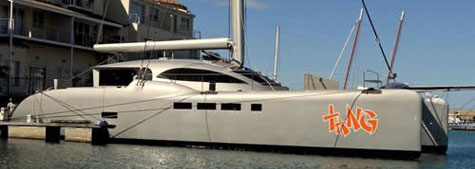
When I had a sailboat, I hated motoring. The diesel was loud and vibrated, completely different from why I went out sailing in the first place. Tag Yachts in South Africa, in partnership with Electric Marine Propulsion and International Battery, may have solved the problem in their new 60-foot catamaran named Tang. When not under sail, the boat is powered by electric motors. When sailing the propellers are turned by the boat’s wake and recharge the batteries. There are also twin diesel generators to recharge the batteries when not under sail or on shore power. The catamaran is built of carbon fiber. The owner plans on sailing the boat to Florida and to make an appearance at the Miami Boat show in February.
Wind-generated electricity powers 60 foot hybrid-electric catamaran

Funny, one of my former colleagues (I also knew him from college days) had this idea too. He equippped his boat, an elderly Columbia 36 I think, with an electric motor powered by a bank of golf cart batteries. He said there was enough “juice” from being plugged in overnight that he could get into and out of his marina berth on just the motor, raising the sails when outside the breakwater. This was in about 1990.
My own experience is totally different — I would never have electric drive as auxiliary to sail. When I owned my first cruising boat I also disliked being under power. However, I soon realized that being under sail in less than 5 knots of wind was worse — not only boring but you were also not going anywhere. So, I hardened my heart and learned to accept the bellow of a 2-cycle outboard, and later a 1-cylinder diesel. Over a period of time my criteria for when to crank up the iron tops’l got more and more stringent. In the time of my last boat I would ruthlessly fire it up whenever the speedometer registered under 3 knots.
What does this have to do with electric drive? Simple — if the wind is less than 5 knots but you still want to move on to your next harbor, you can depend on a well maintained engine to do it for you. Electricity, the weakest element on any sailboat, is likely to fail any time, and if you have to use it all day, your battery will be flat by the time you get to your next harbor. In fact, when winds were good I frequently ran my battery flat just powering the instruments! My colleague countered that the true sailor doesn’t leave harbor if it’s blowing less than 10. Well, in Chesapeake Bay you can’t tell if it’ll keep blowing even if it’s OK when you set out, so to me that didn’t seem convincing.
It is all a matter of the technology. I would love to have a reliable electrical propulsion system on a sailboat. I would love to motor along without the noise and vibration of a diesel engine. With lithium batteries instead of the old lead and acid beasties it all might work. Of course Tang does have twin diesel generators so she she isn’t quite fossil fuel free.
In the near terms I’m sticking to kayaks. The paddles never need recharging, though sometimes the paddler does.
l’hydrogènènaveur: a French sailor who sailed around the world with these on his boat said they were good enough to supply enough energy for his needs, but the sharks kept going for them as they seemed to spin at a frequency similar to speeding fish.
Hey Christina. I have heard of similar problems with trailing logs and knot meters. Fortunately the shaft mounted propellers on the Tang should be less attractive to sharks.
I saw this boat at harbortown marina in fort.pierce florida